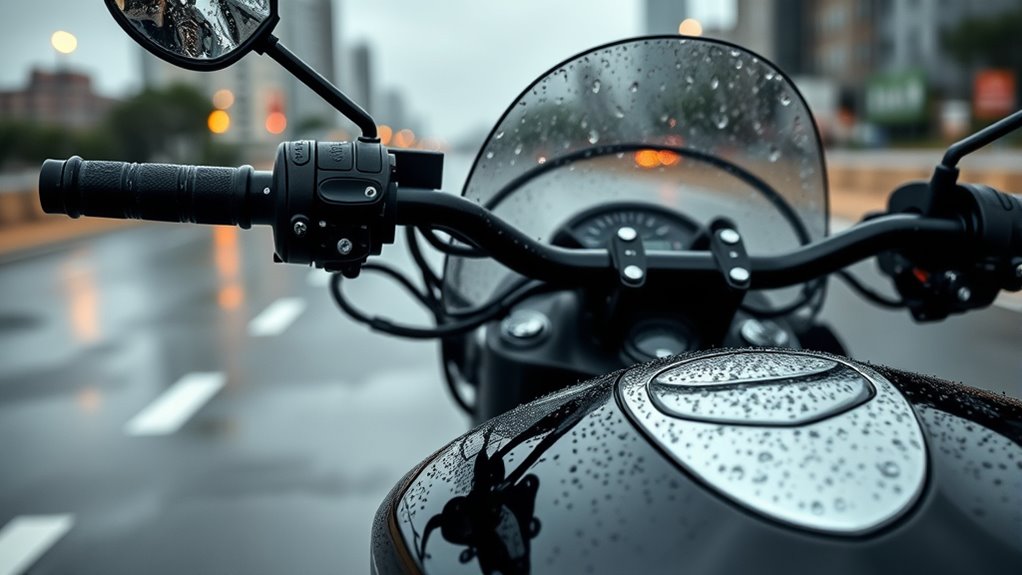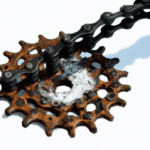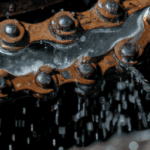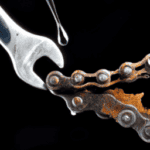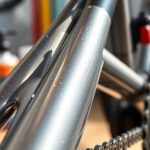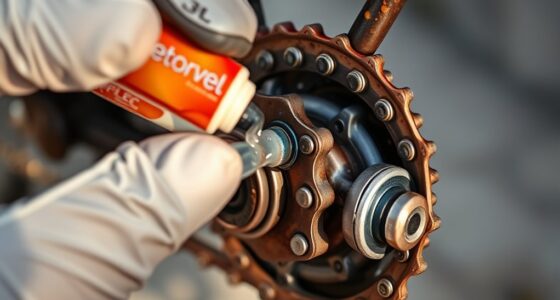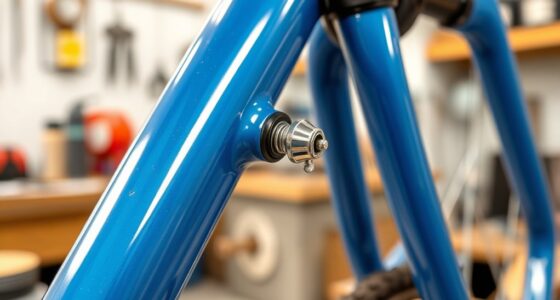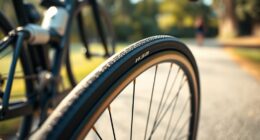To avoid rust when riding in rain, regularly clean and dry your bike after rides, focusing on removing dirt from brakes, rims, and chains. Lubricate moving parts with bike-specific oil to prevent moisture buildup. Use protective coatings like wax or sealants on metal surfaces and store your bike in a dry place. Keep an eye on brake pads and cassettes, and perform periodic deep cleanings. If you stay consistent, you’ll keep rust at bay—and there’s more useful advice to discover.
Key Takeaways
- Clean and dry your bike thoroughly after riding in the rain to remove moisture and prevent rust formation.
- Regularly inspect and maintain brake pads, rims, and chain, ensuring they are clean, dry, and well-lubricated.
- Apply protective coatings like bike wax or sealants to metal parts to create a water-resistant barrier.
- Store your bike in a dry, sheltered area and use covers to protect it from moisture when outside.
- Use appropriate wet-weather lubricants on the chain and moving parts to prevent rust and ensure smooth operation.
Immediately Clean and Dry Your Bike After Rainy Rides

After a rainy ride, it’s essential to clean and dry your bike promptly. Make sure you remove the wheel quickly to access and clean the gears and braking surfaces. Use a clean cloth to wipe down all parts, especially the rims, brake pads, and chain, to remove moisture and dirt. Pay close attention to areas prone to rust, like the chain and metal components, and dry them thoroughly. If your bike has carbon fiber parts, be cautious to avoid abrasive cleaners that could damage the surface. Once everything is dry, consider applying a light coat of bike-specific lubricant or chain lube to protect metal parts from rust and moisture damage. Regular maintenance is key to preventing corrosion and ensuring your bike stays in top condition. Proper cleaning after rain helps maintain performance and prolongs your bike’s lifespan. Additionally, inspecting for any signs of corrosion can help catch issues early before they cause significant damage. Incorporating rust protection techniques, such as applying anti-rust sprays or sealants, can further safeguard your bike from future moisture-related issues. Using appropriate cleaning tools, like brushes designed for bike components, can also improve the effectiveness of your cleaning routine. Remember, investing in protective coatings can provide an extra layer of defense against moisture and prolong your bike’s durability.
Focus on Brake Surface and Rim Maintenance

Once you’ve cleaned and dried your bike, paying close attention to the brake surfaces and rims is essential for maintaining peak performance. After a couple of hours, dirt, moisture, and debris can settle on these areas, leading to rust and reduced braking efficiency. Use a gentle, damp cloth for a little bit of extra cleaning, removing any grime that may cause corrosion. Regularly inspect and clean the brake pads to prevent dirt buildup, which hampers braking and accelerates wear. Make sure the brake surface is thoroughly dried to avoid rust formation. It’s best to wait until everything is completely dry before riding again, as moisture left on the rims or brake surface can invite rust and compromise safety. Proper maintenance keeps your bike performing smoothly in all weather conditions, especially when considering appliance integration for maintenance tools and accessories. Additionally, employing AI-powered maintenance tools can help detect early signs of rust or wear, prolonging your bike’s lifespan. Incorporating rust prevention techniques, such as applying protective coatings, further safeguards your bike against adverse weather effects. Using moisture-resistant lubricants on moving parts can also provide extra protection against rust in rainy conditions. Being proactive about low-maintenance solutions helps ensure your bike remains resilient during rainy rides.
Regularly Lubricate and Care for the Chain
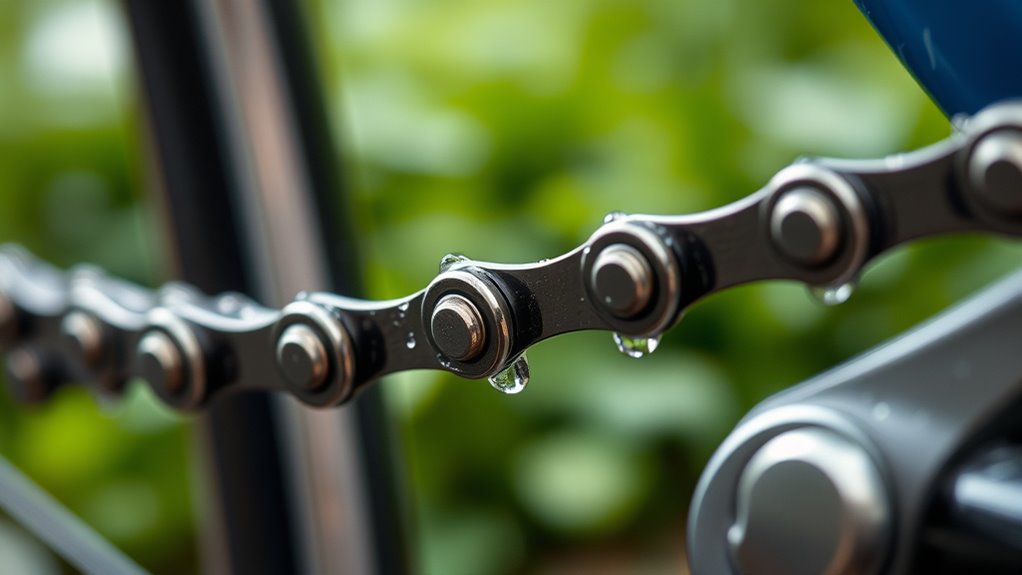
To keep your chain rust-free, make sure you regularly clean and lubricate it, especially after riding in wet conditions. Watch for signs of wear, like looseness or stiffness, which indicate it’s time for maintenance. Using the right lubrication technique guarantees your chain stays protected and lasts longer. Additionally, choosing the appropriate lubricant type for your riding environment can significantly improve its effectiveness. Regularly inspecting your chain for corrosion signs can help catch issues early and prevent costly repairs.
Proper Chain Lubrication Methods
Proper chain lubrication is essential for maintaining smooth performance and preventing rust, especially after riding in wet conditions. To do this effectively, first spin the chain backward to remove water and dirt. Then, use a degreaser or alcohol to thoroughly clean the chain, ensuring all grime and moisture are gone. Once dry, apply a light, even coat of chain lube designed for wet environments, focusing on the rollers and pins. After lubing, wipe off any excess to prevent dirt buildup and keep the chain running smoothly. Regular inspection and re-lubrication after wet rides are crucial for ongoing protection. Remember that proper maintenance helps prevent rust and extends your drivetrain’s lifespan. This routine also benefits from understanding glycolic acid benefits for skin, which emphasizes the importance of regular care for long-term health. Additionally, incorporating sound healing science concepts into your maintenance routine can help you stay mindful and attentive to your bike’s needs. Consistent care, including preventative measures, keeps your bike in top shape, rain or shine.
Signs of Chain Wear
Regularly inspecting your chain is essential because signs of wear can develop quickly, especially after riding in the rain. One key indicator is elongation, which you can measure with a chain wear tool—if it’s stretched, it’s time to replace it before it damages the cassette. Listen for squeaking or stiff links; these noises signal inadequate lubrication and potential wear. Proper cleaning and lubrication after rain rides remove water and debris that accelerate rust and deterioration. A well-maintained chain should run smoothly and quietly; any roughness or noise suggests it needs attention. Regular care, including cleaning and lubrication, not only prevents rust but also extends the lifespan of your chain and drivetrain components, ensuring your bike performs reliably in wet conditions. Additionally, understanding the importance of Jeep Tuning can help vehicle owners optimize their performance for challenging environments, similar to how maintaining your bike ensures reliability in adverse weather. Recognizing the signs of chain wear early allows for timely intervention, preventing costly repairs and ensuring safety during your rides. Paying attention to correct lubrication practices helps protect your chain from moisture-induced rust and corrosion, and incorporating regular chain inspections into your maintenance routine can further prevent unexpected failures.
Use Appropriate Cleaning Tools and Techniques
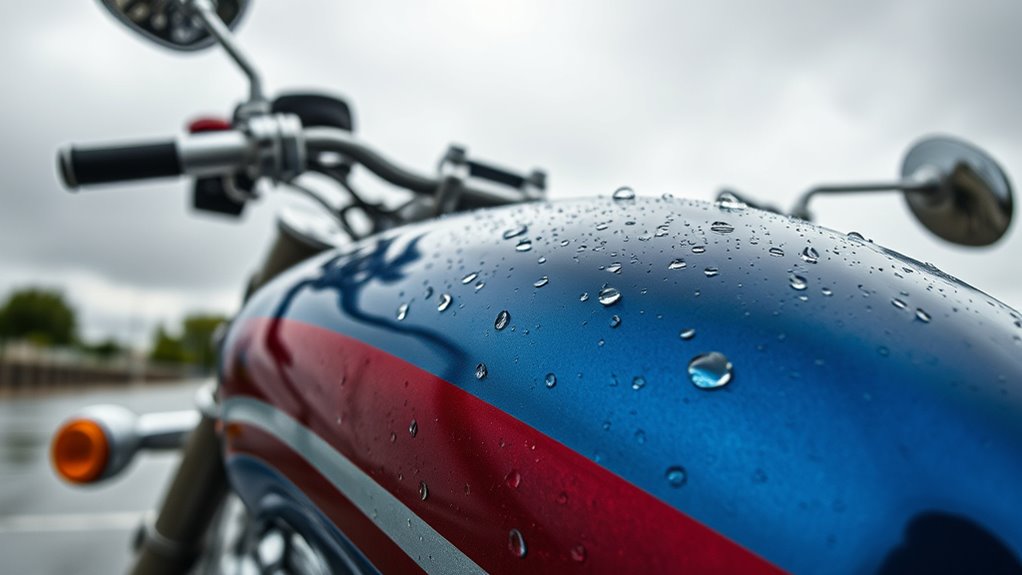
Using the right cleaning tools is essential to protect your bike from rust. Soft, lint-free cloths or microfiber towels gently remove moisture and dirt without scratching surfaces. Applying proper techniques guarantees a thorough clean that keeps your bike in top shape after rainy rides.
Use Soft Cleaning Cloths
Have you ever wondered how to clean your bike effectively after rain without causing damage? Using soft cleaning cloths is key. A lint-free microfiber cloth gently wipes down all surfaces, preventing scratches and removing dirt. Avoid abrasive materials that can harm the paint, decals, or delicate parts of your bike. For tricky spots like gears, brake calipers, and frame joints, use small, soft brushes or cloths to reach tight areas carefully. Slightly dampen the cloth with water or a bike-specific cleaner to boost dirt removal without soaking your bike. Remember to regularly wash or replace your cloths to keep them free of debris that could scratch your bike’s surface. Proper cleaning tools help maintain your bike’s condition and prevent rust.
Apply Proper Cleaning Techniques
To effectively clean your bike after rain, choosing the right tools and techniques is essential. Use a soft, clean cloth or microfiber towel to wipe down all surfaces, avoiding abrasive materials that could scratch paint or components. A small brush or toothbrush helps reach tight spots like gears, chainrings, and brake calipers, ensuring dirt and debris are thoroughly removed. For stubborn grime or grease, apply a bike-specific degreaser with a brush, then wipe with a damp cloth to prevent residue buildup. After washing, dry all parts completely with a clean cloth to prevent water spots and reduce rust risk. Regularly inspect and clean brake pads, rims, and other metal parts with a cloth to remove dirt and moisture that could speed up corrosion.
Inspect and Remove Dirt From Hard-To-Reach Areas
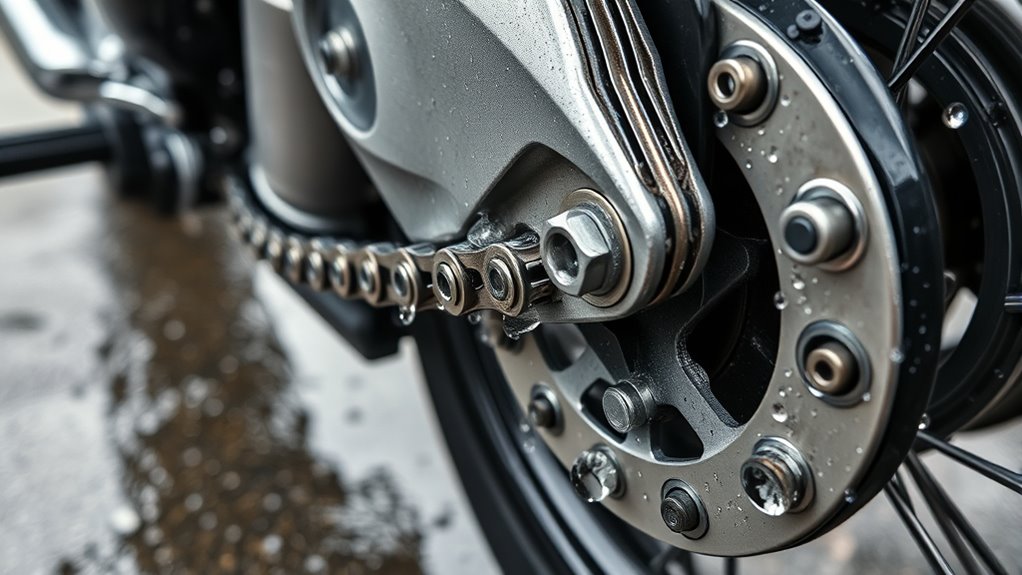
Rain can leave dirt and debris in the hard-to-reach areas of your bike, which can cause rust and damage over time. To prevent this, you need to inspect and clean those tricky spots. Use a small brush or toothbrush to reach into tight spaces around derailleurs, brake calipers, and frame joints, dislodging dirt effectively. Carefully check behind brake pads, inside chainring gaps, and near cable housings—clean these with a damp cloth or compressed air if you have it. When needed, remove the wheel to access the hub, cassette, and spoke nipples for a detailed cleaning. Remember to regularly inspect and clean chainstay and seatstay junctions, as grime tends to gather there and promote rust. Keeping these areas clean ensures your bike stays protected and rust-free.
Store Your Bike in a Dry, Sheltered Location
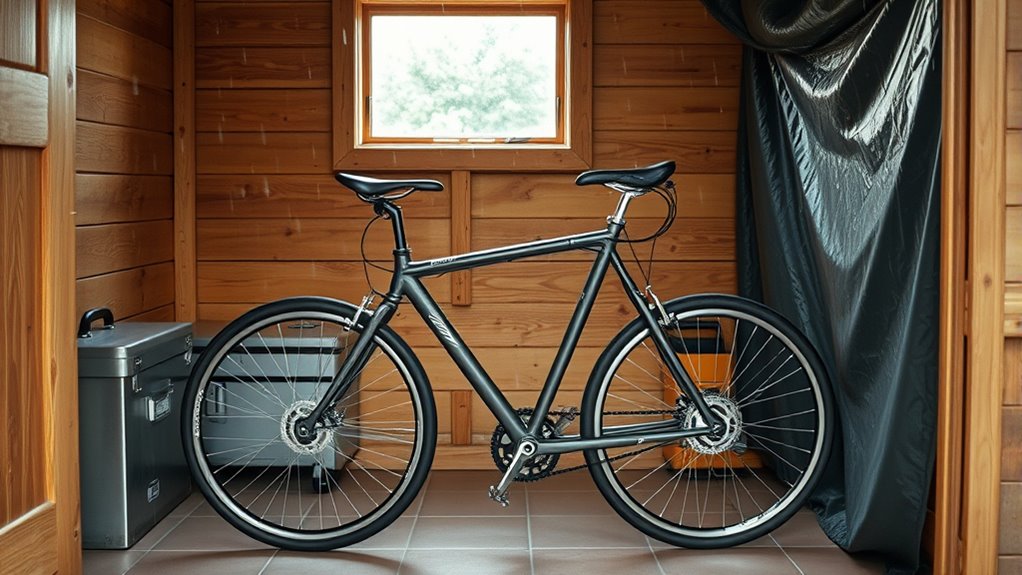
Storing your bike in a dry, sheltered spot keeps moisture away and protects metal parts from rust. You can choose a covered garage or shed, or use a quality bike cover if stored outdoors. This simple step helps your bike stay rust-free longer and ready to ride.
Choose a Covered Storage Space
Choosing a covered storage space for your bike is one of the most effective ways to prevent rust caused by rain and moisture. A dry, sheltered area shields your bike from the elements, reducing the risk of rust on metal parts. It also helps preserve lubricants on chains and gears, extending their lifespan. Indoor storage or shaded spots keep your bike cleaner and require less maintenance caused by weather-related corrosion. To maximize protection, consider these options:
- Use a garage or shed for complete coverage
- Park under a carport to block rain
- Place your bike in a shaded corner
- Install a secure, covered bike rack
Storing your bike properly in a protected space keeps it in top condition and minimizes rust over time.
Use Protective Bike Covers
Using protective bike covers is an effective way to keep your bike dry and shielded from moisture. A waterproof cover prevents rainwater from contacting your bike, drastically reducing rust risk on metal parts. Make sure to store your bike in a dry, sheltered spot like a garage, shed, or covered porch to limit exposure to humidity. Choose a properly fitted cover with venting features to prevent condensation buildup, which can cause rust over time. Regularly inspect and clean your bike before covering it, removing dirt and water that could lead to corrosion. Investing in a high-quality, breathable cover not only protects your bike from rain and dew but also prolongs its lifespan by shielding it from environmental moisture. This simple step offers ongoing protection against rust formation.
Apply Protective Coatings to Metal Components
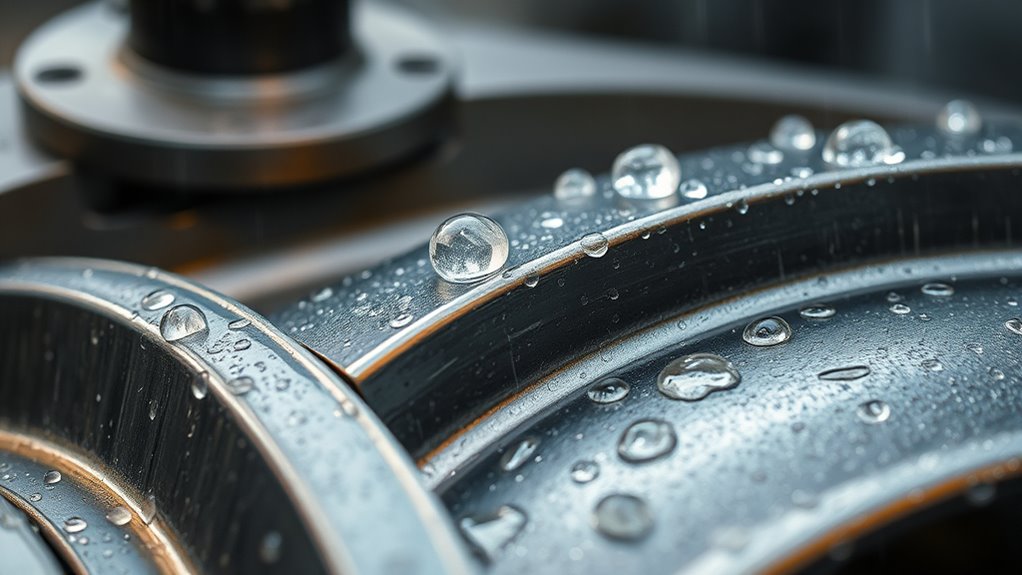
Applying protective coatings to your bike’s metal components is an essential step in preventing rust, especially when riding in the rain. These coatings create a barrier that repels water and inhibits corrosion. You can use bike-specific protective wax or sealant to form a thin, effective layer. Penetrating oils like WD-40 displace moisture on bolts and exposed metal parts, offering ongoing protection. Clear corrosion inhibitors can be sprayed onto metal surfaces, forming a transparent shield without affecting appearance. For longer-lasting results, consider ceramic or nano-coatings, which provide durable, water-resistant barriers. Remember to reapply coatings regularly after cleaning or rain exposure to maintain rust resistance. Consistent application ensures your bike stays protected and rides smoothly, no matter the weather.
Check and Maintain Brake Pads and Cassettes
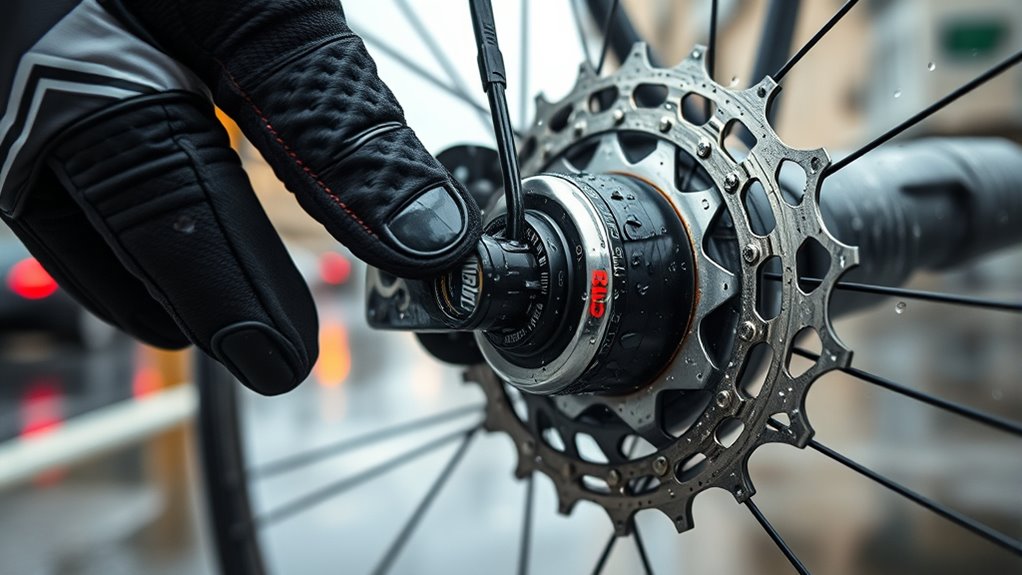
After riding in the rain, it’s important to inspect your brake pads and cassettes for dirt and moisture buildup. Wipe them clean with a cloth to guarantee your brakes stay responsive and effective. Regularly check for rust or corrosion on these components, and if you notice any, apply a rust inhibitor to prevent long-term damage. Keep your brake pads dry and free of dirt by cleaning them after wet rides; this maintains ideal stopping power. Additionally, applying a light layer of lubricant to the cassette can help prevent rust on exposed metal surfaces. Promptly drying and cleaning your brake parts after rain reduces moisture contact, considerably lowering the risk of rust developing over time and ensuring your braking performance remains reliable.
Perform Full Bike Cleanings Periodically

Performing full bike cleanings periodically is key to maintaining your bike’s performance and preventing rust. Regular deep cleans remove dirt, grime, and moisture that can cause corrosion over time. They also help you spot early signs of rust or damage, so you can address issues before they worsen. Make sure to clean all surfaces, including hard-to-reach areas, to prevent moisture buildup. Using proper cleaning products and lubricants creates a protective barrier, shielding your bike from moisture and rust formation. Establishing a routine of thorough cleaning after riding in wet conditions substantially extends the life of your components.
- Remove and clean chain, gears, and derailleurs
- Scrub the frame and hard-to-reach spots
- Dry all parts thoroughly
- Apply protective lubricants and rust inhibitors
Prevent Rust With Additional Anti-Corrosion Measures
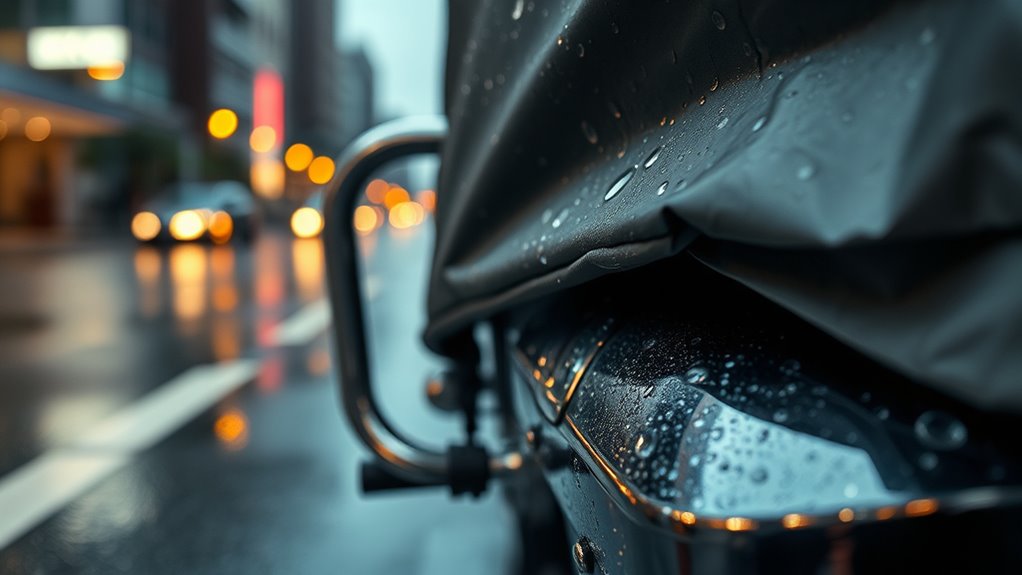
To effectively prevent rust after riding in the rain, you should focus on implementing additional anti-corrosion measures. Applying a high-quality anti-corrosion spray or wax to metal parts creates a protective barrier that blocks moisture from causing rust. Regularly inspecting your bike and reapplying corrosion inhibitors, especially after rain exposure, ensures long-term protection for critical components like the chain, cassette, and brake surfaces. Immediately drying all bike parts after riding in the rain reduces residual moisture that could lead to rust formation. Using lubricants with anti-corrosion properties on the chain and metal joints adds an extra layer of defense. Additionally, storing your bike in a dry, sheltered location minimizes humidity exposure and substantially cuts down the risk of rust developing over time.
Frequently Asked Questions
How Do You Ride in the Rain Without Getting Wet?
When riding in the rain, you can stay dry by wearing waterproof gear, including a jacket and pants. Use front and rear fenders to block water splashes, and lean forward slightly to reduce rain hitting your face. Ride at a moderate pace for better control, and choose tires with good grip. These steps help keep you dry and safe, making your wet ride more comfortable and less stressful.
How to Prevent a Bike From Rusting After Rain?
To prevent your bike from rusting after rain, you’ll want to act fast—don’t let the grass grow under your feet. Immediately dry all metal parts, especially the chain, rims, and gears, to wipe out moisture. Clean and inspect for dirt, then apply a light coat of bike-specific lubricant to protect against rust. Store your bike in a dry spot and check it regularly to keep corrosion at bay.
Will My Motorbike Rust if I Ride It in the Rain?
Riding your motorbike in the rain doesn’t automatically mean it’ll rust. However, moisture exposure can cause rust if water lingers on metal surfaces. To prevent this, you should dry your bike thoroughly afterward and apply protective coatings like wax or rust inhibitors before riding. Regular maintenance, such as lubrication and cleaning, also helps keep your bike protected, so you can enjoy rainy rides without worrying about rust.
How to Safely Ride a Motorcycle in the Rain?
To ride safely in the rain, you should slow down and keep a greater distance from other vehicles. Use both brakes gently to prevent skidding, and make sure your tires have good tread and proper air pressure for better grip. Wear waterproof, high-visibility gear to stay dry and see clearly. Avoid deep puddles to prevent hydroplaning and hidden hazards, ensuring a safer, more controlled ride.
Conclusion
Think of your bike as a trusty steed; with proper care after rainy rides, it’ll stay strong and ready for the next adventure. By cleaning, drying, and protecting your bike, you prevent rust from sneaking in like a silent thief. Keep up with regular maintenance, and your bike will glide through puddles and rainstorms just as gracefully as it does on sunny days. Treat it well, and it’ll reward you with many miles of smooth, rust-free riding.
